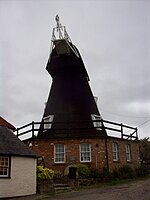Woodnesborough railway station
Disused railway stations in KentFormer East Kent Light Railway stationsPages with no open date in Infobox stationRailway stations in Great Britain closed in 1948Railway stations in Great Britain opened in 1916 ... and 1 more
Use British English from August 2015
Woodnesborough railway station was a railway station on the East Kent Light Railway. It opened on 16 October 1916 and closed to passenger traffic after the last train on 30 October 1948. The station served the village of Woodnesborough. There was a 500-gallon water tank and a siding. A half mile long branch served Hammill Brick Works, built on the site of the aborted Hammill Colliery. Today the station site is now covered by industrial buildings.
Excerpt from the Wikipedia article Woodnesborough railway station (License: CC BY-SA 3.0, Authors).Woodnesborough railway station
Hammill Road,
Geographical coordinates (GPS) Address External links Nearby Places Show on map
Geographical coordinates (GPS)
| Latitude | Longitude |
|---|---|
| N 51.2601 ° | E 1.2923 ° |
Address
Woodnesborough
Hammill Road
CT13 0PR
England, United Kingdom
Open on Google Maps






